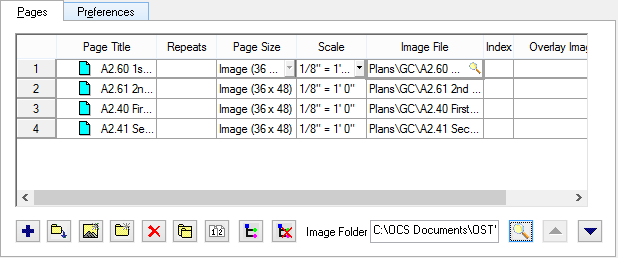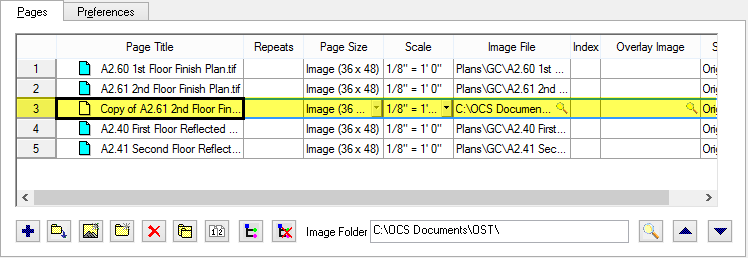![]()
10.01.00 adding (linking) images to a bid
![]()
One of the primary functions of On-Screen Takeoff is allowing you to view project plans (Images, or electronic plans, plan files, or blueprint files). When you add Images to a project, they aren't actually being stored inside the database. On-Screen Takeoff just creates a link (a reference, so to speak) to the image files.
For detailed instructions on creating a Bid and how to add or manage images, watch the Training Video (Internet connection required). If you just have questions about adding images, fast-forward to 5:00 in the video.
When you add images from a CD or Flash Drive, that CD or Flash Drive must be in the CD-ROM every time the Bid is opened in order for those images to be displayed. On Center Software recommends copying the contents of any CDs to a local or network drive first then linking the Cover Sheet to that location (do not link files to a removable drive). (If you use the Bid Wizard, OST automatically copies all files to the local hard drive.)
Image links are specified on the Pages tab on the Cover Sheet. If the images are moved from their original location after being linked to, it is necessary to update the location of each page file. See the article Reassociating Image Files for detailed instructions on updating the file location if it changes.
See the next article for information on which image file types you can use with On-Screen Takeoff.
This article assumes that you are not using the Bid Wizard. When using the Bid Wizard, adding images is done during Bid creation and the files are all copied to the default Planroom folder. See Bid Wizard for more information.
On the Cover Sheet, the pages grid shows a list of all pages currently added to the project, where the image file is stored, and page details such as size and scale.

There are eight columns on the Pages tab:
Field |
Description |
Page Title |
When linking to an image file, if that document has an internal page title, it is displayed here, if not, the Image File name is displayed. |
Repeats |
Indicates the number of times this particular page is repeated. See Adding Repeating Pages for more information. |
Page Size |
Defaults to the Page Size listed under Tools>Options>New Bid unless specified in the image file. |
Scale |
Defaults to the Scale listed under Tools>Options>New Bid unless specified in the image file. The program can calculate the scale if it is in doubt.
|
Image File |
Along with the Image Folder at the bottom of the Cover Sheet, indicates the actual file to which this project page is linked. (If the file is located in the "Image Folder", the file name will only show unique information for this file (sub-folder and name). |
Index |
When the Image File is a multi-page document (several pages within a single file, such as a mutli-page PDF), the Index indicates that page number to be displayed on the Image Tab for this project page. |
Overlay Image |
Specifies the Overlay Image - Overlays cannot be indexed files (multiple pages in one file). |
Show |
Drop down list allows user to select whether to display the Original, Overlay, or Both images. |
The Image Folder indicates the common directory structure for linked files. In the example above, notice the pages only show the Image File and extension - that's because they are all in the "Image Folder". If the Image File is stored in the Image Folder, then it shows the file name and extension, if it is in a different folder, the entire directory structure displays.

Button |
Description |
What it does |
|
Add new page (blank) |
Inserts a new blank page one line below the currently selected line |
|
Add Images |
Automatically adds images of the same file type (*.tif, *.pdf, etc.) from a selected folder |
|
Add new page and link to image |
Inserts a new page and opens the image file selection dialog |
|
Add new folder |
Adds a new folder immediately below the last folder in the list - allows estimator to organize the pages for easier page navigation. See Using Folders to Organize Your Plans for more information. |
|
Delete |
Deletes the current selection - cannot be undone
|
|
Change Folder |
Changes the folder where the currently selected page(s) are stored |
|
Duplicate Page |
Duplicates the selected page (does not duplicate the takeoff) (only works with a single page at a time) |
|
Expand Image Folders |
When working with folders on the Pages tab in the Cover Sheet, this expands all image folders. |
|
Collapse Image Folders |
When working with folders on the Pages tab in the Cover Sheet, this collapses all image folders. |
|
Image Folder (and lookup button) |
Indicates the common directory where the first images added to the Bid are stored. For example, in the screen shot above, Image files which only show an image name or partial path/name are stored in this "Image Folder", those showing a full path/name are not stored in the Image Folder and On-Screen Takeoff is storing the complete path to the image file. The lookup button allows the estimator to change the folder, in the event the majority of images are moved to a different location. |
|
Move Up button |
Allows estimator to move a single page or congruent group of pages up in the grid, one row at a time. |
|
Move Down button |
Allows estimator to move a single page or congruent group of pages down in the grid, one row at a time. |
When first adding PDFs to a Bid, OST prompts you to convert the images to a TIFF format. Converting to TIFF format is optional, but recommended.
TIFFs require fewer system resources to display than PDFs and provide for better overall performance.
Most image files can be converted to TIFF from the Image Tab after they have been loaded - see Converting Plan Images to TIFF.
Before you do ANY takeoff in your project, VERIFY the scale of EACH drawing you'll be using, see Verifying the Scale of an Image.
To add blank pages to a project, open the Bid Cover Sheet
and on the Pages tab, click the Add
button ![]() .This adds a blank page to the project. Now,
to assign (link) an image to the new page, see below. If you are
using a digitizer, add the total number of pages needed before
starting takeoff. Set page size and, if known, the scale for each
page.
.This adds a blank page to the project. Now,
to assign (link) an image to the new page, see below. If you are
using a digitizer, add the total number of pages needed before
starting takeoff. Set page size and, if known, the scale for each
page.
Blank pages are added with the settings specified under Tools > Options > New Bid.
To link images to Bid pages:
 in the Image File column for each page to link to
an image
in the Image File column for each page to link to
an imageThe page size (or dimensions) may only be changed immediately after the blank page is inserted - once an image is linked to a page the page size is unchangeable.
To add a single page linked to an image file using default page size and scale settings:

To duplicate an existing page:
Click the Duplicate Page button  - a copy of the selected page is added directly below the original page
named "Copy of [duplicated page’s
name]".
- a copy of the selected page is added directly below the original page
named "Copy of [duplicated page’s
name]".

Takeoff and annotation from the original page is not duplicated. If you duplicate a Typical Page (a page with "Repeats", the duplicate page contains the same number of Virtual Pages as the original.
To add a group of images of the same file type (*.tiff; *.pdf, *.dwf, etc.) from a particular directory:

When automatically adding pages in this manner, all image files of the same TYPE are added. For example, if there are .tiff, .pdf and .cal image files in the folder, to add all images, perform the Auto Add Images steps three separate times to grab all three types of files